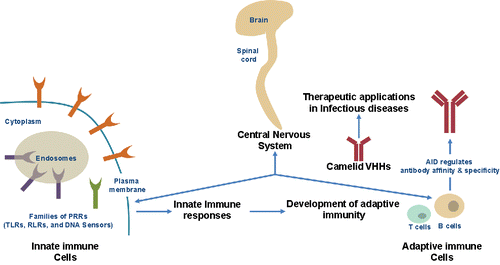Hosts are equipped with two major arms of immune defense to combat pathogens. One arm is non-specific also known as innate immunity, having broad range specificity relative to the molecular signatures of pathogens. Sensing of pathogens by the innate immune component promptly initiate elimination through an array of molecules (complement, anti-microbial peptides and so on) and various cellular processes such as phagocytosis. Another arm is highly pathogen-specific known as adaptive immunity and elicits delayed response through B and T lymphocytes. The effector responses of both arms are tightly regulated to minimize deleterious effects to normal host physiology. This issue of the International Reviews of Immunology describes various aspects of innate and adaptive immunity and also describes the therapeutic potential of adaptive immune component (antibodies) from camel family in bacterial and viral infections ().
Figure 1. Role of innate and adaptive immunity in disease development. PRRs, Pattern recognition receptors; CitationTLRs, CitationToll-like receptors; RLRs, RIG-I-like receptors; VHH, Heavy-chain variable domains; and AID, activation-induced cytidine deaminase.

The innate sentinel cells express various families of pattern recognition receptors (PRRs) which sense unique biomolecules associated with pathogen known as pathogen-associated molecular patterns (PAMPs), to induce appropriate immune responses. The first two review articles of this issue by Dolasia et al. and Vidya et al broadly focus on PRRs and role in shaping the pathogen-specific adaptive immunity mediated through B and T lymphocytes. The first review article by Dolasia et al. discusses the effector immune responses induced upon sensing of microbial pathogens by CitationToll-like receptors Citation(TLRs) and NOD-like receptors Citation(NLRs). The authors highlighted the potential of CitationTLRs/NLRs ligand based therapeutics. The second review article by Vidya et al. describes the different PAMPs sensed by CitationTLRs and the various molecules involve in signaling to activate key transcription factors and MAP kinases to induce an anti-microbial state. The authors also discuss the influence of host genetics in the development of innate immune responses. Collectively, both articles proposed development of PRR ligand-based therapeutics and corresponding diagnostics for infectious diseases ().
Synthesis of appropriate antibodies against antigenic determinants of pathogens is one of most crucial steps in the development of protective immunity against the pathogens. The antibodies are produced by mature B cells. In these B cells, activation-induced cytidine deaminase Citation(AID) plays a critical role in ensuring the affinity or avidity of antibodies. The third review article by Choudhary et al. provides an update of AID in B cell biology, and in antibody production. Additionally, the authors discuss immune diseases associated with dysregulation of CitationAID. The review also reviews the correlation between AID-related cancer therapeutics and other translational aspects associated with CitationAID biology. ().
The central nervous system Citation(CNS) plays an essential role in perceiving stimuli and responding to them. In mammals the CitationCNS is considered to have less immune activities due to the blood brain barrier. The fourth review article of this issue by Negi et al, highlights the fact that CitationCNS is not only immune active but it is also intimately associated with the lymphatic system. Moreover, the authors also discuss the cerebrospinal fluid comprising various immune cells such as dendritic cells, macrophages, natural killer cells, and T cells. The article presents the delicate balance of immune activity and immune tolerance which may lead to better understanding of several neurologic disorders linked to aging. Therefore, this review is helpful to the researchers working on various aspects of neuro-immunology and aging ().
The antibodies are playing an instrumental role in diagnosis and therapy of many infectious and non-infectious diseases; however, their applications may be limited due to suboptimal stability, specificity and solubility. The last review article of this issue by Wilken et al. describes the heavy-chain variable domains Citation(VHHs) produced by camel family and their versatile properties, as compared to human antibodies. The article proposes the substitution of conventional antibodies by CitationVHHs in the quest to advance new therapies ().
References
- Dolasia Komal, Bisht Manoj K, Pradhan Gourango, et al. TLRs/NLRs. Shaping the landscape of host immunity. Int Rev Immunol. 2018;37(1):3–19.
- Mallenahally Kusha Vidya, Girish V. Kumar, Sejian Veerasamy, et al. Toll-like receptors. Significance, ligands, signaling pathways, and functions in mammals. Int Rev Immunol. 2018;37(1):20–36.
- Choudhary Meenal, Tamrakar Anubhav, Singh Amit Kumar, et al. AID Biology. A pathological and clinical perspective. Int Rev Immunol. 2018;37(1): 37–56.
- Negi Neema and Das Bimal K. CNS. Not an immune-privileged site anymore but a virtual secondary lymphoid organ. Int Rev Immunol. 2018;37(1):57–68.
- Wilken Lucas and McPherson Anne. Application of camelid heavy-chain variable domains (VHHs) in prevention and treatment of bacterial and viral infections. Int Rev Immunol. 2018;37(1):69–76.
